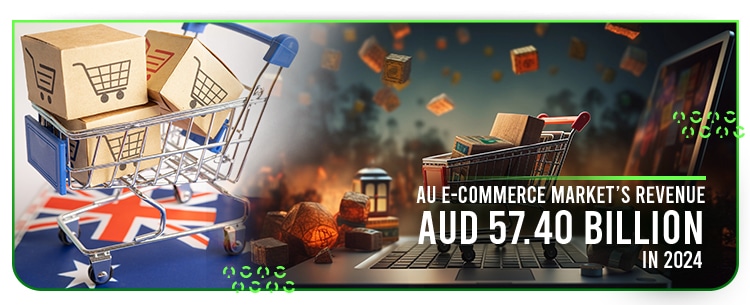Today, a physical store is no longer necessary to conduct business.
According to the 2023 Australia Post E-commerce Industry Report, more than 5.6 million Aussies shop online each month. Evidently, the e-commerce and digital retail industry is currently one of the fastest-growing industries in Australia.
As more and more Aussies shop online, there are many new digital retail trends to look out for.
However, the e-commerce industry also faces many challenges related to its growth, such as intense competition and logistics and supply chain issues.
So, how can AU businesses tap into this industry, and what does the future of e-commerce look like?
Scroll down for a detailed overview of the AU online retail market.

Just How Big is Australia’s E-Commerce Industry?
Currently, the Australian e-commerce and digital retail industry is enjoying rapid growth.
E-commerce has reached roughly 91% of over 10 million Aussie households, and this number continues to grow.
Because of this, the AU e-commerce market’s revenue is projected to reach USD 37.10 Billion (AUD 57.40 Billion) in 2024, according to Statista.
Additionally, the annual e-commerce growth rate (Compound Annual Growth Rate (CAGR) 2024-2029) is 9.36%, resulting in a projected market volume of USD 58.03 Billion (AUD 89.90 Billion) by 2029.
Furthermore, the average revenue per user (ARPU) is expected to grow to USD 2172.00 (AUD 3365.40).

High User Penetration in the Australian Market
User penetration for e-commerce in 2024 is currently estimated at 65.3% and is expected to hit 84.4% by 2029, according to Statista.
Here are some factors for e-commerce’s high user penetration in the Australian retail market:
Internet and Smartphone Penetration
E-commerce has greatly benefited from improvements in Australia’s internet connectivity. This makes it much easier to connect to distant customers and manage an online business, wherever business owners may be.
In addition, the proliferation of AU’s e-commerce marketplaces, with their accompanying mobile apps, makes it easier for customers to order things online.
This convenience, coupled with the increasing popularity of Buy Now Pay Later (BNPL) schemes and other forms of secure digital payment, makes online shopping the preferred purchasing method for many Aussies.
The most popular AU e-commerce marketplaces include:
- Catch: Boasting 25,000 sales daily with an average spend of USD 130 (AUD 201), Catch is one of AU’s most popular e-commerce platforms.
- Amazon Australia: Despite being a recent addition to the AU digital marketplace, Amazon already reached over USD 1 Billion (AUD 1.55 Billion) in net sales back in 2020.
- eBay: As one of the oldest online marketplaces in Australia, eBay attracts 12 million monthly unique visitors. This reliable stream of customers has helped thousands of stores generate more than USD 1 Million (AUD 1.55 Million) in sales.
Consumer Demographics and Online Behaviour
A 2023 survey showed that millennials were the most frequent online shoppers, with around 57% of this generational group shopping groceries online.
On the other hand, only 35% of boomer respondents reported doing the same.
That said, the online purchase behaviour of younger generations is much more restrained due to their considerably lower purchasing power.
In contrast, older generations are much less restrained, since they already have established careers and stable incomes.
These consumer behaviour trends highlight a growing generational gap in digital buying habits due to economic conditions and differences in priorities.
For further insights on e-commerce consumer spending habits per generation, here are some online shopping statistics based on Australia Post’s 2024 Insights Report:
- Gen Z (2006-1998) spent the most on fashion items (AUD 2.4 Billion (23%) of AUD 10.6 Billion).
- Gen Y (1997-1981) spent the most on home and garden items and specialty food and liquor (both are at AUD 5.1 Billion (23%) of AUD 22.1 Billion).
- Gen X (1980-1965) spent the most on home and garden items (AUD 4.8 Billion (27%) of AUD 17.5 Billion).
- Baby Boomers (1964-1946) spent the most on home and garden items (AUD 3.6 Billion (29%) of AUD 12.5 Billion).
Impact of the COVID-19 Pandemic
The sudden appearance of COVID-19 and subsequent lockdowns in 2020-2021 led to a significant surge in online shopping.
Online spending peaked in September 2021, with 1 in 4 retail dollars being spent online.
Although e-commerce growth seemed to have slowed down with the end of the pandemic’s end, it continues to hold a significant share of total retail spending at 16.8% and this number is expected to continue rising.

International Market Opportunities
The growth of the e-commerce and digital retail industry also opens up the possibility of expansion into international markets for AU businesses.
Although this prospect can be exciting, it does come with its own challenges.
To succeed in a bigger marketplace, it’s best to consider:
Cross-Border E-Commerce
According to AU Post’s 2023 Report, 28% of Aussies purchased products from international sellers in 2022.
Most (40%) of these purchases were from China, followed by the US (21%), UK (14%), Hong Kong (6%), and New Zealand (3%).
In contrast, only 6% of international buyers purchased from Aussie online sellers. Additionally, Statista research also suggests that cross-border commerce only accounts for 10% of the total e-commerce market.
Fortunately, advances in international shipping and logistics make it faster and more reliable to ship internationally.
Additionally, AU businesses have an edge in niches like skincare products, health supplements, and iconic Australian goods like wine and wool products.
The most popular 3rd Party Logistics (3PL) and carriers in Australia are:
- Australia Post,
- DHL,
- Aramex Australia (Formerly Fastway Couriers),
- Strartrack, and
- UPS.
Finally, the AU government and various trade organizations provide support and resources to help Aussie businesses export their products.
Export Strategies for Australian Businesses
Here are some strategies AU businesses can use to successfully expand their operations in the international market:
- Conduct a thorough e-commerce market analysis:
-
- Identify key international markets with high demand for their company’s products.
- Tailor their business’s products and marketing strategies to fit their target market’s local preferences and online purchase behaviour.
-
- Leverage Free Trade Agreements (FTAs)
-
-
- Utilize Australia’s FTAs to reduce tariffs and simplify customs processes.
- Remain updated on new and existing trade agreements to optimize export strategies.
-
- Optimize Their Business’s Online Presence
-
-
- Create localized versions of their website with language translation and local payment options.
- Implement international SEO strategies and use local social media platforms for marketing.
-
- Efficient Logistics and Shipping
-
-
- Partner with reliable logistics providers for cost-effective and timely shipping.
- Use overseas warehouses and fulfillment centres to reduce shipping times.
-
- Payment Solutions
-
-
- Integrate global payment gateways supporting multiple currencies and popular payment methods.
- Provide transparent pricing, which includes shipping, taxes, and duties.
-
- Customer Service and Support
-
-
- Offer multilingual customer service to enhance customer experience and satisfaction.
- Implement straightforward return policies to build trust and encourage repeat purchases.
-
Challenges and Solutions
Some of the most common issues faced by Aussie companies expanding to international clients are:
- Market Competition
-
- Intense competition from both local and international competitors makes it difficult for Aussie companies to stand out.
- Solution: Implement strong and focused branding and marketing strategies to differentiate their products from competitors. Emphasize what makes their products/services unique and/or superior to competitors to attract customers.
- Logistics and Supply Chain Issues
-
- Australia’s distance from major global markets can lead to high shipping costs and delays.
- Solution: AU Businesses should partner with reliable logistics providers and use advanced logistics software to track and optimize their supply chain management. They may also consider using local fulfillment centres to reduce shipping time and costs.
- Regulatory Compliance
-
- Navigating domestic and international trade regulations can be complex and time-consuming.
- Solution: Remain informed about regulatory changes through industry associations and sound legal advice. Additionally, implement compliance management systems to ensure adherence to all regulations and standards.
- Customer Expectations and Experience
-
- Meeting the rising customer expectations for quick service, high-quality products, and excellent customer support is very challenging.
- Solution: AU businesses can utilize customer feedback to continually improve their products/services and implement customer relationship management (CRM) systems to boost customer support.
- Cybersecurity Threats
-
- Increasing cybersecurity threats can jeopardize a company’s operations and erode customer’s trust.
- Solution: Invest in robust cybersecurity measures like encryption, firewalls, and regular security audits. Additionally, AU businesses should train their employees to implement the best cybersecurity and data protection practices.

Understanding Consumer Preferences and Behaviour
Understanding the target audience is crucial to business success.
Thus, here are some digital shopping trends influencing consumer behaviour:
Factors Influencing Online Purchase Decisions
The most common factors influencing online purchasing behaviour are:
- Sustainability and Ethical Business Practices: According to AU Post’s 2024 report, 93% of Gen Z buyers consider sustainable and ethical practices a priority and 56% of other consumers prefer slower delivery options for sustainable options.
- That said, AU businesses should be careful when branding their companies as “sustainable,” as this could lead to accusations of greenwashing.
- Instead, they should be honest about their business practices and strive to achieve authentic sustainability.
- Prices and Discounts: Competitive pricing and attractive discounts are major factors for online purchases.
- Product Rating and Reviews: Positive online reviews from previous customers can significantly influence potential customers’ purchasing decisions.
- Payment Options: Having multiple secure payment options like credit/debit cards, digital wallets, and buy now pay later (BNPL) services caters to different consumer preferences and increases the likelihood of completing a purchase.
- Brand Trust and Loyalty: Having a strong brand reputation and customer loyalty programs leads to repeat purchases and long-term customer loyalty. According to AU Post’s 2024 report, 53% of online shoppers favour a more personalized shopping experience from retailers.
- Sales Events: Events like Black Friday, Boxing Day, and End of Financial Year Sales (EOFYs) saw a significant leap in the number of online purchases compared to 2019, with an 88%, 65%, and 75% increase in volume, respectively.
Popular Product Categories
Last year, Aussies spent AUD 63.6 Billion on online purchases.
The most common products they purchased are:
- Home and Garden: AUD 16.0 Billion, YoY Growth -7.6%.
- Variety Stores: AUD 15.8 Billion, YoY Growth +9.1%.
- Food and Liquor: AUD 13.2 Billion, YoY Growth +2.4%.
- Fashion: AUD 9.6 Billion, YoY Growth -8.7%.
- Hobbies and Rec. Goods: AUD 3.9 Billion, YoY Growth -2.0%.
- Health and Beauty: AUD 2.9 Billion, YoY Growth -2.0%.
- Books, Print, and Stationery: AUD 1.6 Billion, YoY Growth -1.8%.
The Role of Social Media and Influencers
Maintaining a strong presence on social media sites like Facebook, Instagram, and TikTok helps AU companies reach a broader audience quickly and effectively.
Aside from this, collaborating with well-known social media influencers can further boost their brand and attract new customers.
When an influencer endorses a company’s product/service, their followers are more likely to trust them and make a purchase.
Companies can also tailor their collaborations to specific age groups, so that their message resonates better with their target audience.
For example, partnering with younger influencers are ideal for businesses that target Gen Zs and Millennials.

FAQs
Here are some of the most commonly asked questions about the e-commerce and digital retail industry:
What is the Current State of E-Commerce in Australia?
The AU e-commerce landscape is enjoying significant growth, as more consumers are shopping online than ever before.
Factors like high user penetration, increased internet access, and the ease and convenience of online shopping propel its growth.
How Has the Pandemic Affected E-Commerce in Australia?
The COVID pandemic helped accelerate the shift to online shopping, as the lockdowns forced people to buy essentials and other products/services online.
Despite the official end of the lockdown, this trend persists as people find shopping online to be faster and more convenient.
What Are the Key Opportunities for Australian Businesses in the International Market?
Key opportunities for AU businesses in the international market include Australia’s numerous free trade agreements with major Asian countries and targeting Asia’s growing middle class.
Additionally, they can also take advantage of the demand for clean and green products and innovative technologies.
What Are the Main Challenges in the Australian E-Commerce Market?
The most common challenges in the AU e-commerce landscape are high market competition, logistic and delivery issues, customer expectations, varying regulatory laws, and cybersecurity threats.

Conclusion
Australia’s e-commerce and digital retail sector have seen tremendous growth recently, as more and more appreciate its convenience.
For Aussies planning to start their own online business and/or target international clients, now’s a great time to do so.
Looking to scale or put up an online business but need alternatives to traditional staffing solutions to get things done faster? Click here to learn more.
John Carlo Pagsolingan is a carefree yet hardworking writer with aspirations of becoming a teacher in the future. He believes that remote working isn’t just a substitute; but is a legitimate alternative to face-to-face work. Learn more as he writes about the advantages of remote work and tips for aspiring remote workers.





















